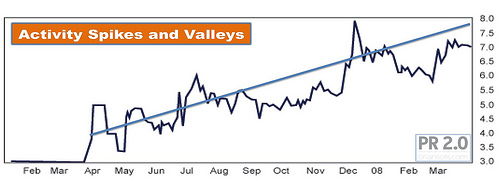Part II (cont.)
Click here to read “PR Does Not Stand for Press Release: Equalizing Spikes and Valleys (Part I)”
If you’ve studied the behavior and ensuing results associated with retweeting and linkbacks lately, you’d be surprised to learn just how few people actually click through to interact with the shared content, let alone using or referring the product or service contained in the link — no matter how influential you are. Of course, the more authority and trust you possess, the more retweets and shares you earn, but the follow-through never fails to dissipate without fuel and cultivation. This observation is shared in a recent launch comparison by Michael Arrington on TechCrunch.
The point is that if we base our activity on news and events, the results will always produce spikes and valleys, and the distance between them is determined by the cadence of our news releases and the effectiveness in how well we generate presence and corresponding traffic. Unfortunately, as the attention of our customers continues to thin and the competition for awareness escalates, the distance between the spikes and valleys may be the difference between success and obsolescence.
The trick is how to counter the balance and disparity between apex and nadir.
The answer is to create programs that match the results from the initial research of identifying the people and channels of influence within every facet of the customer bell curve — from the head to the Long Tail.

I call this a “Yo Yo on an Escalator,” as your traffic can go up and down, but through a dedicated practice of community, awareness and advocacy programs, the cumulative traffic is always going up — especially in between news cycles.
It’s the difference between a campaign mindset and one of community cultivation.
Every launch or news strategy should be supported by an ongoing program of community building and influencer engagement from the a-list all the way to the Magic Middle (the group of people who reach and impact peers of potential and existing customers and decision makers through blogs, twitter and other social networks). Now, if you re-read my quote from the NYT again, it starts to make more sense …
Extending the value proposition within multiple horizontal and vertical markets is not only beneficial, but critical for any company hoping to compete for the future. The belief that there is only one market and one channel and one opportunity for your story is not only confining, but also dangerous.
As I said in the Times article, we’re striving to reach and compel “a category that includes those in mainstream media as well as the tens of thousands of bloggers and Twitter users who have developed avid followings by writing about niche topics.”
Again, there is no one market for our one message. Our value propositions must speak to those influencers and decision makers looking for information that speaks specifically to them, understanding not only what galvanizes action but also pays homage to their unique needs and experiences.
These individuals represent the landscape of traditional and new media authorities that occupy mainstream and niche markets and form a pyramid stacked on varying degrees of leverage.
It’s our responsibility to identify and prioritize all important categories equally in order to run both a top-down and bottom-up communications program that increases visibility, demonstrates awareness and empathy, offers solutions and inspires champions who can help us extend and scale explicit benefits for particular groups of consumers. In doing so, we can create a series of concentric circles that, when nurtured individually, resonate and extend until they collectively overlap and form a topography of collaborative, burgeoning and overlapping conversations and communities that extend the reach of companies to cultivate dedicated channels.
In the end, relationships and expertise serve as the currency of PR and influence and without them, the ability to connect stories, earn trust, empower advocates, and build vibrant communities is implausible.
The eligibility to earn these relationships however, start with a completely new and enlightened state of market awareness, customer empathy, and social adeptness, bound by passion and a clear proficiency in the art and science of influence and community building.
In the new world of communications, PR stands for Public Relations. – again
 Brian Solis is the principal of FutureWorks, an online public relations/communications firm he founded in 1999. He is a co-founder of the Social Media Club, a national organization that convenes events for the purpose of sharing best practices, establishing standards and promoting social media literacy. He is an original member of the Media 2.0 Workgroup and also contributes to the Social Media Collective. He recently co-authored “Putting the Public Back in Public Relations” (March 2009 FT Press). Connect with Brian on Twitter, FriendFeed, LinkedIn, Tumblr, Plurk, Identi.ca, BackType or on Facebook.
Brian Solis is the principal of FutureWorks, an online public relations/communications firm he founded in 1999. He is a co-founder of the Social Media Club, a national organization that convenes events for the purpose of sharing best practices, establishing standards and promoting social media literacy. He is an original member of the Media 2.0 Workgroup and also contributes to the Social Media Collective. He recently co-authored “Putting the Public Back in Public Relations” (March 2009 FT Press). Connect with Brian on Twitter, FriendFeed, LinkedIn, Tumblr, Plurk, Identi.ca, BackType or on Facebook.
Join Brian at the Meet the Experts networking session and “Putting the Public Back in Public Relations in PR” co-author, Deidre Breakenridge, along with Joseph Jaffe, Juliette Powell and Ariel Hyatt, for the panel discussion, “Social Media and the PR (R)Evolution: It’s Not Just PR Anymore,” at the PRSA 2009 International Conference: Delivering Value, November 7-10 in San Diego, CA!






